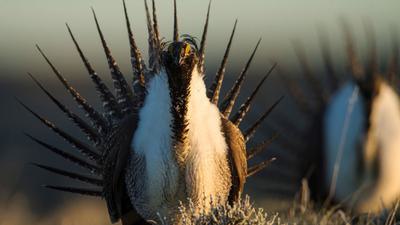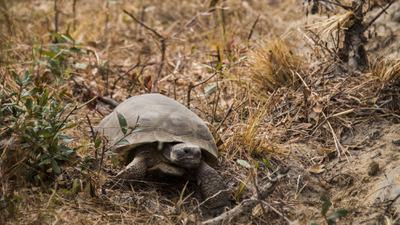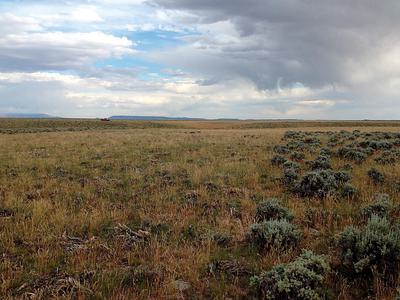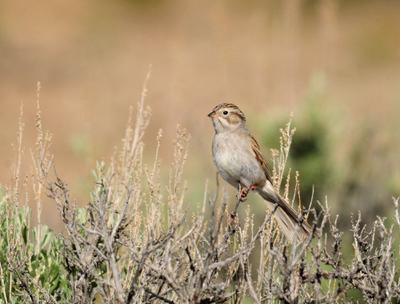Conservationists often criticize state fish and game departments for focusing single-mindedly on one species to the detriment of everything else — for instance, improving habitat for elk, which then browse down habitat for songbirds. But what if conservationists — who don’t have that traditional hook-and-bullet mindset — nonetheless inadvertently do much the same thing?
That’s one implication of new research looking at the umbrella species concept, one of the fundamental ideas driving conservation efforts worldwide. It’s the idea routinely advocated by conservationists that establishing and managing protected areas for the benefit of one surrogate species — from gorillas to grizzly bears — will also indirectly benefit a host of other, less charismatic species sharing the same habitat. “The umbrella species concept is an appealing shortcut,” says Jason Carlisle, who conducted the research as a doctoral candidate at the University of Wyoming. But the complications quickly pile up.
Across much of the American West, the greater sage grouse is one such umbrella species. It’s widely considered (but not officially listed as) an endangered species, with a population down from millions of individuals across 16 states and three Canadian provinces a century ago to fewer than 400,000 in a sharply reduced and fragmented range today.
The species that stand out to human eyes don’t always turn out to be the best umbrella species for their habitat.
In 2015, an unprecedented consortium of states, federal agencies, private landowners, industry, and environmentalists agreed to a painstakingly negotiated collaboration to protect the sage grouse and to make it an umbrella for 350 other “background” species in sagebrush habitat. Then, last August the Trump Administration threw out that Obama-era agreement and reopened sage grouse habitat on federal lands to additional mining, drilling, cattle grazing, and off-road vehicle use — all factors that helped imperil sage grouse in the first place.
In reality, Carlisle and his co-authors suggest, the protective umbrella created under the 2015 agreement should have been even larger, at least in Wyoming. The researchers mapped the extent of semi-protected habitat for sage grouse statewide and then overlaid that onto habitat maps for background species. According to the resulting report in the Journal of Wildlife Management, the proposed conservation umbrella would have protected only 82 percent of the state’s sage grouse population. For 52 background species of conservation concern, it was even worse: The umbrella covered as little as 0 to 63 percent of their habitat. Making the umbrella concept effective, that study concluded, requires far more careful consideration of “the characteristics of the umbrella species, the reserve delineated on its behalf, and the similarity of the umbrella species to its purported background species.”
A gopher tortoise on the Eglin Air Force Base in Florida, which contains the world's largest contiguous acreage of old-growth longleaf pine. U.S. Air Force/Samuel King Jr.
The species that stand out to human eyes don’t always turn out to be the best umbrella species for their habitat. In Florida’s longleaf pine forests, for instance, the red-cockaded woodpecker might seem like the natural umbrella species for establishing protected areas. It’s a “flagship” species in the sense that it has obvious charismatic appeal for engaging policy makers and the public. It’s also a “keystone” species, meaning that it has a positive influence on the structure or function of its ecosystem. But “flagship” and “keystone” don’t automatically add up to umbrella species. When researchers at the University of Florida applied a battery of ecological criteria to longleaf pine forests, they found that the gopher tortoise, another keystone species, provided a broader umbrella for threatened species in that habitat. Likewise, researchers in central Europe recently concluded that a list of 168 beetle species found on decaying wood would provide an effective umbrella for identifying and protecting relict stands of primeval forest.
Even a carefully chosen umbrella species can leave holes in coverage for certain background species. A past study of a plan to make grizzly bears an umbrella species in Idaho found, for instance, that birds, mammals, and amphibians would benefit as background species, but most reptiles wouldn’t. A study of East African nature reserves originally established to protect large mammals found mixed results for small mammals. Even so, author Tim Caro, a conservation biologist at the University of California at Davis, argued that umbrella species had been “an effective conservation shortcut perhaps because most reserves were initially large and could encompass substantial populations of background species.” The takeaway from all these studies: Umbrella effects are seldom as simple as they seem.
In sagebrush patches mowed to benefit sage grouse, there was a loss of habitat for Brewer’s sparrow and sage thrasher.
In their sage grouse research, Carlisle and his co-authors also looked beyond the question of whether a protected area established for an umbrella species covers the right habitat, or enough of it. In a separate study published in The Condor, they also asked a surprisingly uncommon question about conservation initiatives: How does a management practice intended to benefit an umbrella species affect other, non-target species in the same habitat?
One common management treatment that’s intended to improve habitat for sage grouse is the removal of the sagebrush canopy by mowing or other means. The theory is that opening up dense, woody sagebrush stands encourages understory vegetation and insects, both consumed at certain stages in their development by sage grouse chicks. Carlisle and his co-authors didn’t focus on the proposed benefit to the sage grouse, though that’s a topic of increasing debate. (A 2017 study by co-authors Kurt Smith and Jeffrey Beck found largely negative effects on sage grouse population.) Instead, they looked at changes in three “background species” of songbirds: Brewer’s sparrow and sage thrasher, both almost exclusively seen in sagebrush habitat, and vesper sparrow, commonly found in both sagebrush and grassland habitat.
Mowed (left) and unmowed (right) patches of sagebrush in sage grouse habitat in central Wyoming in 2015. Jason Carlisle
The study area was a central Wyoming site within both state and federally designated priority habitat for sage grouse. The treatment — mowing sagebrush to a height of about 10 inches — took place in February 2014, before bird nesting season, and covered a patchy mosaic in a stand of sagebrush that was otherwise uncut. Carlisle and his co-authors surveyed the area before treatment and for two years after.
The result: A complete loss of nesting habitat for Brewer’s sparrow and sage thrasher in mowed patches. The mowing treatment also cut the overall abundance of sage thrashers in half. But vesper sparrows seemed to take advantage of the new habitat for nesting and became more abundant in mowed areas. The co-authors noted that the sagebrush could take decades to recover from the treatment — though the long-term effects on other sagebrush species are unknown. They also emphasized that the mowing treatment was only patchily distributed in their study area, adding that “our findings are not applicable to forms of high-intensity, uniform disturbance that result in wholesale conversion of large areas of sagebrush-steppe, including some forms of agricultural, exurban, and energy development.”
Too often when scientists talk about umbrella species, said Liba Pejchar, a Colorado State University conservation biologist who was not involved in the study, “we either make assumptions or are not explicit about the assumptions we are making.” Conservationists rarely ask — or answer — the question, “Is what’s good for one species also good for others in that ecosystem?” The real take home, she added, “is that we need to do the science to determine if there are going to be winners or losers. It doesn’t mean we shouldn’t do these things,” but scientists and society should go in understanding the potential tradeoffs.
All sides were willing to support the plan to restore sage grouse habitat before the Trump administration discarded it.
Both Pejchar and Anna D. Chalfoun, a University of Wyoming wildlife ecologist and senior author on the sagebrush studies, also questioned some of the specific assumptions that went into the sage grouse umbrella species idea. “There seems to be a culture in the West that getting rid of sagebrush will somehow benefit some wildlife species,” said Chalfoun. “But really I think it might be a legacy of simultaneously benefiting ranching practices and then hoping it might benefit things like sage grouse. This idea that sage grouse are this benevolent umbrella for all the other species out there has been stated as fact by a lot of professionals — not biologists necessarily — and we thought that deserved some really vigorous study.”
Pejchar noted that sage grouse restoration programs in western Colorado also emphasize removal of sagebrush and piñon-juniper, another native species. “It’s something that they can quantify. They can say we cleared this many acres of juniper, or we removed the shrub cover in this many acres of habitat, and they can report back,” she said, with such actions presumably helping to fend off any eventual endangered species listing. “That’s my general sense for why some of these approaches may be attractive. Sometimes I think it might be easier to do small-scale habitat manipulations than it is to address some of the primary underlying drivers of decline.” Those include cattle grazing, mining, oil and gas drilling, wind energy development, off-road vehicle use, and real estate construction, all on former sage grouse habitat.
Brewer's Sparrow, seen here on Seedskadee National Wildlife Refuge in Wyoming, lose their nesting habitat when sagebrush is mowed for the benefit of protected sage grouse. Tom Koerner/USFWS
One other factor may also have motivated the enthusiasm of land managers for clearing sagebrush, said Mark Salvo of the conservation nonprofit, Defenders of Wildlife: The practice is good for mule deer and elk, both popular game species that also benefited from the 2015 agreement to protect the sage grouse and make it an umbrella for 350 other “background” species in sagebrush habitat. “Everybody was willing to support the plan, and give it a chance to work,” he said, before the Trump Administration threw it out.
The irony, said Salvo, is that Interior Secretary Ryan Zinke went on this past March to order agencies to protect corridors and winter habitat — exactly as the Obama-era sage grouse agreement would have done — but this time only for elk, mule deer, and pronghorn. That is, in place of what Salvo called “a useful if imperfect umbrella species” concept of protection for entire ecosystems, we are back for now to the old-fashioned promotion of game species above all — and to hell with everything else.






